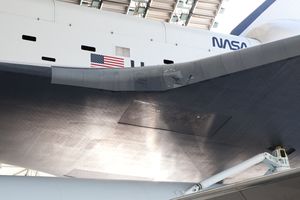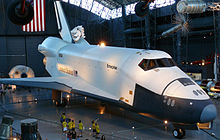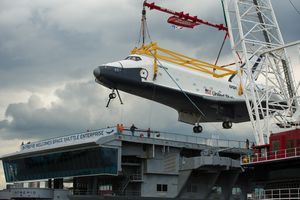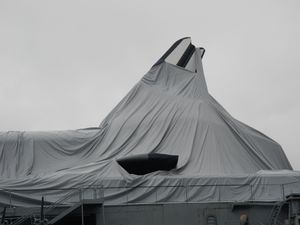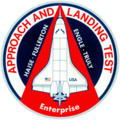Space Shuttle Enterprise
40°45′53″N 74°00′03″W / 40.764832°N 74.000763°W
| Enterprise OV-101 | |
|---|---|
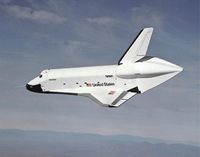 Enterprise in flight in 1977, during ALT-13 | |
| تسمية عربة مدارية | OV-101 |
| الدولة | United States |
| عطاء المقاولة | July 26, 1972 |
| سـُمّي على اسم | يوإسإس Enterprise (NCC-1701) (Star Trek starship) |
| أول رحلة | ALT test flight on SCA February 18, 1977 |
| آخر رحلة | Ferry flight on SCA April 27, 2012 |
| الوقت المنقضي في الفضاء | None |
Space Shuttle Enterprise | |
| الموقع | New York City |
| بُنيَ | 1976 |
| بناه | Rockwell International |
| رقم NRHP المرجعي | خطأ لوا: invalid capture index %2 in replacement string. |
| أضيف إلى NRHP | March 13, 2013 |
| الوضع الحالي | Retired, on display at Intrepid Museum, New York City |
Space Shuttle Enterprise (Orbiter Vehicle Designation: OV-101) was the first orbiter of the Space Shuttle system. Rolled out on September 17, 1976, it was built for NASA as part of the Space Shuttle program to perform atmospheric test flights after being launched from a modified Boeing 747.[1] It was constructed without engines or a functional heat shield, and was therefore not capable of spaceflight.[2]
Originally, Enterprise had been intended to be refitted for orbital flight to become the second space-rated orbiter in service.[1] However, during the construction of مكوك فضاء Columbia, details of the final design changed, making it simpler and less costly to build Challenger around a body frame that had been built as a test article.[1] Similarly, Enterprise was considered for refit to replace Challenger after the latter was destroyed, but Endeavour was built from structural spares instead.[1][3]
Enterprise was restored and placed on display in 2003 at the Smithsonian's new Steven F. Udvar-Hazy Center in Virginia.[4] Following the retirement of the Space Shuttle fleet, Discovery replaced Enterprise at the Udvar-Hazy Center, and Enterprise was transferred to the Intrepid Sea, Air & Space Museum in New York City, where it has been on display since July 2012.[5]
الفروق بين إنترپرايز والمكوكات المستقبلة
The design of Enterprise was not the same as that planned for Columbia, the first flight model; the aft fuselage was constructed differently, and it did not have the interfaces to mount OMS pods. A large number of subsystems—ranging from main engines to radar equipment—were not installed on Enterprise, but the capacity to add them in the future was retained, as NASA originally intended to refit the orbiter for spaceflight at the conclusion of its testing. Instead of a thermal protection system, its surface was primarily covered with simulated tiles made from polyurethane foam. Fiberglass was used for the leading edge panels in place of the reinforced carbon–carbon ones of spaceflight-worthy orbiters. Only a few sample thermal tiles and some Nomex blankets were real.[6] Enterprise used fuel cells to generate its electrical power, but these were not sufficient to power the orbiter for spaceflight.[7]
Enterprise also lacked RCS thrusters (which were useless in atmospheric flight) and hydraulic mechanisms for the landing gear; the landing gear doors were simply opened through the use of explosive bolts and the gear dropped down solely by gravity.[7] As it was only used for atmospheric testing, Enterprise featured a large nose probe mounted on its nose cap, common on test aircraft because the location provides the most accurate readings for the test instruments, being mounted out in front of the disturbed airflow.
Enterprise was equipped with Lockheed-manufactured zero-zero ejection seats like those its sister Columbia carried on its first four missions.[7]
مراجل الإنشاء
| Date | Milestone[8] |
|---|---|
| 1972 July 26 | Contract Award to North American Rockwell |
| 1972 August 9 | Construction authorization from NASA |
| 1974 June 4 | Start structural assembly of crew module at Downey plant |
| 1974 August 26 | Start structural assembly of aft fuselage at Downey plant |
| 1975 March 27 | Mid fuselage arrives at Palmdale from General Dynamics |
| 1975 May 23 | Wings arrive at Palmdale from Grumman |
| 1975 May 25 | Vertical stabilizer arrives at Palmdale from Fairchild Republic |
| 1975 August 25 | Start of Final Assembly |
| 1975 September 9 | Aft fuselage on dock, Palmdale |
| 1975 October 31 | Lower forward fuselage on dock, Palmdale |
| 1975 December 1 | Upper forward fuselage on dock, Palmdale |
| 1976 January 16 | Crew module on dock, Palmdale |
| 1976 March 3 | Payload bay doors on dock, Palmdale |
| 1976 March 12 | Complete final assembly and closeout systems installation |
| 1976 March 15 | Start functional checkout |
| 1976 June | Complete functional checkout, start ground vibration and proof load tests |
| 1976 September 17 | Rollout from Palmdale |
| 1976 October–November | Start systems retest, complete integrated systems checkout |
| 1977 February 18 | First captive flight |
| 1977 June 18 | First crewed captive flight[9] |
| 1977 August 12 | First free flight |
الخدمة
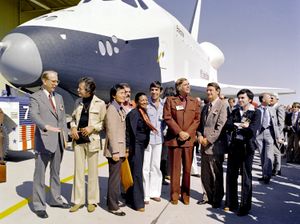
إنترپرايز (تعيين ناسا: OV-101) اول سفينة فضائية على مر كل العصور كانت سفينة صغيرة في احدى المحطات الأمريكية حتى أصبحت اول وأكبر سفينة فضائية على وجه الأرض وقد انشئ صدفة مسلسل لاق إقبالا كبيرا بحيث كان يتضمن البش وبعض المخلوقات الأخرى يعني الكائنات الفضائية ومنها الفولكن والتراثوريون والكثير.
اختبارات الاقتراب والهبوط (ALT)
On January 31, 1977, Enterprise was taken by road to Dryden Flight Research Center at Edwards Air Force Base to begin operational testing.[1][10]

بعد تشالنجر
After the Challenger disaster, NASA considered using Enterprise as a replacement. Refitting the shuttle with all of the necessary equipment for it to be used in space was considered, but NASA decided to use spares constructed at the same time as Discovery and Atlantis to build Endeavour.[3]
بعد كلومبيا
In 2003 after the breakup of Columbia during re-entry, the Columbia Accident Investigation Board conducted tests at Southwest Research Institute, which used an air cannon to shoot foam blocks of similar size, mass and speed to that which struck Columbia at a test structure which mechanically replicated the orbiter wing leading edge. They removed a section of fiberglass leading edge from Enterprise's wing to perform analysis of the material and attached it to the test structure, then shot a foam block at it.[11]
العرض في متحف
نيويورك
معرض صور
Space Shuttle Enterprise 747 separation
Enterprise at SLC-6 at Vandenberg AFB
انظر أيضاً
- بوران (مركبة فضائية)
- List of human spaceflights
- List of Space Shuttle crews
- List of Space Shuttle missions
- National Register of Historic Places listings in Manhattan from 14th to 59th Streets
- Timeline of Space Shuttle missions
- تشالنجر (مكوك فضاء)
- ديسكفري (مكوك فضائي)
References
- ^ أ ب ت ث ج Jenkins, Dennis R (2007). Space Shuttle: The History of the National Space Transportation System. Voyageur Press. ISBN 978-0-9633974-5-4.
- ^ Slovinac, Patricia; Deming, Joan (يونيو 2010). Avionics Systems Laboratory/Building 16: Historical Documentation. NASA. JSC-CN-22284. Archived from the original on ديسمبر 12, 2013.
- ^ أ ب خطأ استشهاد: وسم
<ref>غير صحيح؛ لا نص تم توفيره للمراجع المسماةname - ^ "National Air and Space Museum Steven F. Udvar-Hazy Center". NASA. أكتوبر 23, 2003. Retrieved سبتمبر 30, 2015.
- ^ D'Orazio, Dante (يوليو 18, 2012). "NASA Space Shuttle Enterprise aboard the USS Intrepid in pictures". The Verge. Retrieved سبتمبر 30, 2015.
- ^ "Space Shuttle, "Enterprise" OV-101". SI.edu. Smithsonian Institution. Retrieved يناير 9, 2013.
- ^ أ ب ت Lethbridge, Cliff (1998). "Space Shuttle Enterprise (OV-101) Fact Sheet". Spaceline.org. Archived from the original on يناير 7, 2011.
- ^ Garrett, David; Gordon, Bob (أغسطس 25, 1976). "Shuttle roll-out set for 17 September 1976" (Press release). NASA News. 76N-32224. Retrieved يونيو 16, 2013.
- ^ Gebhardt, Chris (أبريل 27, 2012). "Space Shuttle Enterprise – The Orbiter that started it all". NASA Spaceflight. Retrieved يونيو 18, 2015.
- ^ Dismukes, Kim (فبراير 15, 2005). "Space Shuttle Basics". NASA.gov. Retrieved نوفمبر 28, 2007.
- ^ Harwood, William (يونيو 4, 2003). "Critical foam impact test planned for Thursday". Spaceflight Now. Retrieved يوليو 12, 2007.
- Attribution
External links
قالب:Enterprise Spaceships قالب:Space Shuttle Enterprise
- Pages using gadget WikiMiniAtlas
- Short description is different from Wikidata
- Use mdy dates from February 2018
- Coordinates on Wikidata
- Pages using infobox NRHP with unknown parameters
- Portal templates with default image
- صور ناسا
- Individual aircraft
- Crewed spacecraft
- Space Shuttle orbiters
- Individual spacecraft in the collection of the Smithsonian Institution
- Space Shuttle tourist attractions
- Parasite aircraft
- National Register of Historic Places in Manhattan
- مقالات تحتوي مقاطع ڤيديو
- Test spaceflights
- برنامج مكوك الفضاء

